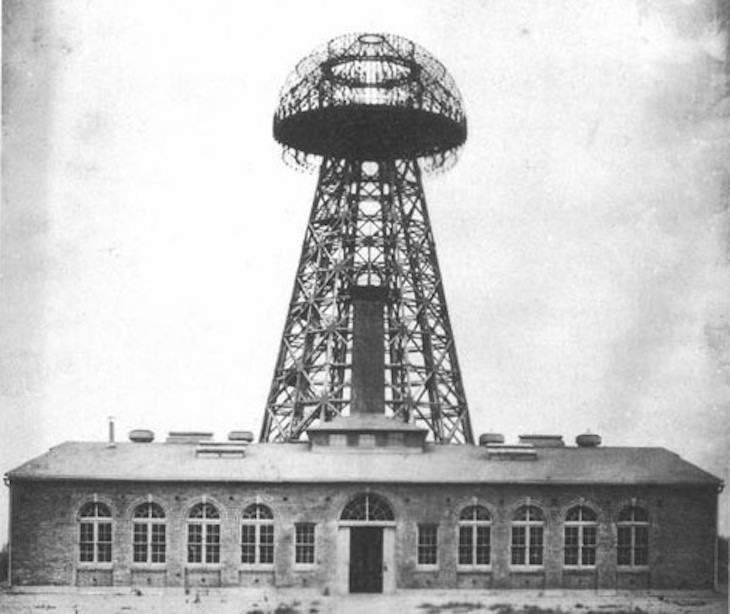
We all learned about water’s boiling and freezing points at school. We know that water stays liquid between 32 and 212°F (or 0 and 100°C). Any lower than that, and it becomes solid. But did you know that it’s actually possible to ‘supercool’ liquid water below its freezing point and have it stay in liquid form?
Here’s how it works. H2O molecules have a distinct "Mickey Mouse" shape, which causes ice crystals to form in a high-volume mesh structure. Like snowflakes, these ice crystals need something to latch on to in order to grow, such as impurities floating in the water. Pure distilled water doesn’t have such impurities. As a result, pure water can be “supercooled” to well below its freezing point.

Nikola Tesla's ideas were heaps and bounds ahead of their time, but the Serbian-American physicist was often misunderstood in his own time. Today, he is widely appreciated for his advancements in the fields of electricity and energy.
One such project was the Wardenclyffe Tower, a wireless telecommunication system that would have been able to transmit power freely across the world. In 1901, the grand project was finally given the green light and generous funding. The financier, J.P. Morgan, decided to invest $150,000 (the equivalent of $4 million today) on the construction of the Wardenclyffe Tower. The project was becoming increasingly ambitious, as Tesla wanted to gain the upper hand over his rival, Guglielmo Marconi, who managed to transmit radio signals between France and England and also transmitted Morse Code across the Atlantic.
Morgan refused to contribute more funds to the project, and Tesla went ahead with his original plan. The tower was erected in 1902, and Tesla carried out experiments there until 1905. Alas, the scientist didn’t manage to launch his beloved telecommunication station, the first of many. Eventually, Tesla lost ownership of the tower, as he couldn't afford the mortgages he took. The tower was demolished in 1917, but Tesla never ceased to believe in his vision.
"It is not a dream," he insisted, "it is a simple feat of scientific electrical engineering, only expensive— blind, faint-hearted, doubting world!" To learn more about Tesla's inventions that never saw the light of day, check out our previous article 7 Inventions of Nikola Tesla That Were Never Built.

Technology is supposed to become more and more efficient as time goes by, right? Well, in theory, yes. But what if we told you that before 1924, the average lifespan of a light bulb was around 2,500 hours? That is nearly 4 months, and in some instances, early light bulbs lasted much longer than that. One light bulb manufactured in 1901 is still burning today, nearly 120 years later!
In December 1924, a global organization known as the Phoebus Cartel hatched a secret plan to increase sales by lowering a lamp’s lifespan to just 1,000 hours. They even re-engineered their own products to achieve this. Today, over a century later, this model is what we’re stuck with.

Have you ever heard of tardigrades? These microscopic animals also go by the nicknames "water bear" or "moss piglet" due to their chubby build and the fact that they are found in mossy aquatic environments.
What makes tardigrades so unique is their ability to survive in the harshest of environments, including elevations of 5546 m (18195 ft) in the Himalayas, boiling hot Japanese hot springs, and even outer space. In 2007, thousands of tardigrades were attached to satellites and blasted into space. After the satellite returned to Earth, scientists found that many of the tiny critters had survived. Not only that, some of the females even laid eggs in space, and the newly hatched young were healthy.
Tardigrades can survive droughts and oxygen deprivation by entering a special state called cryptobiosis. In this state, they tuck in their legs and expel all moisture from their bodies, creating a glass-like layer around them called a tun. In that state, their metabolism slows down to 0.01% of the normal rate. Tardigrades can stay in this cocoon state for decades and only reemerge when they come in contact with water. No wonder that these tough critters managed to survive on our planet for 500 million years!
Related: These Illustrated Facts Show Why Science is So Incredible

Globally, 1 in 12 males and 1 in 200 females are colorblind. That is a pretty stark difference. According to the National Eye Institute, the genes responsible for the most common type of color blindness are found in the X chromosome. People with an X-chromosome and a Y-chromosome only need one X-chromosome to be defective to be colorblind. People with two X-chromosomes, on the other hand, need both to be defective.
Most women have two X-chromosomes (XX), and most men have an X-chromosome and a Y-chromosome (XY). That's why colorblindness is significantly more common in men than in women.

All the stars, planets, and galaxies that can be seen by the human eye make up only 4% of the universe. The remaining 96% is made up of something humans can’t see, detect, or even comprehend - dark matter and dark energy. Astronomers infer the existence of these forces based on the gravitational influence they have on the visible universe.
The understanding that there might be more mass in the universe than the stuff we can see first formed during the 1960s. In the six decades to follow, researchers haven’t been able to figure out the nature of dark matter. A popular hypothesis is that dark matter is formed by exotic particles that don’t interact with regular matter and light. Hence, they are invisible. The overwhelming majority of the universe is, who knows? "It's unknown for now, and possibly forever," as the science writer, Richard Panek, put it.
Related: The Sun: 10 Things to Know About the Star of the Solar System

When you look up at the sky and see the clouds floating above so effortlessly, it’s easy to assume that they are almost weightless. That assumption is very far from the truth. According to scientists, the weight of an average cumulus cloud is 1.1 million pounds! That is the equivalent of 100 elephants or the world's largest passenger jet.
So how does that much weight stay afloat? The simple explanation is that all that weight spread out into millions of droplets over a really big area. Some of these droplets are so small that you would need a million of them to make a single raindrop.
Share these fascinating facts with friends and family